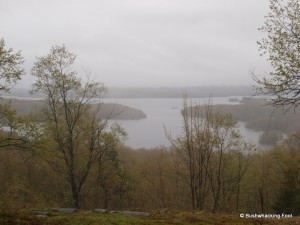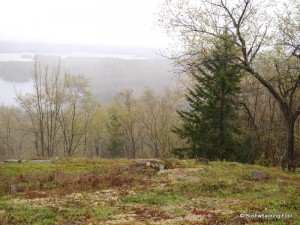Heavy rain is not the ideal weather for the beginning of a bushwhacking trip. Logs and fallen leaves become slippery, streams overflow their banks and mud becomes ubiquitous, especially during mid-spring in the Adirondacks.
This is especially true during the Birdathon in the Pepperbox Wilderness. Unfortunately, the predicted wet weather gave me little choice this year, as both the special day and the day before (which is my set-up day) were supposed to see a significant amount of rain.
Since the predicted heavy rain is for later during the set-up day, my plan calls for waking up early and departing well before the bad stuff begins. Although the waking up part of the plan comes off without a hitch, the hitting the road part is quite lacking.
Just as I depart, the rain starts falling. It picks up even more after it dawns on me that I forgot my dinner for the night in the refrigerator, forcing me to return after only getting a couple miles away. After doubling back and picking up my hit dogs for the evening, I get right back on the road and head out once again.
Section Stats:
Date: May 16, 2014
Length: 0.8 miles (0.8 total daily miles; 0.8 total trip miles)
Difficulty: Moderate (climbing)
The rain keeps up most of my trip north, until finally turning onto the Number Four Road just miles from my destination. The dirt road shows no sign of rainfall whatsoever by the time I reach the small outpost of Stillwater Reservoir, bestowing hope that I may just make it into Cropsey Pond without even getting wet.
At least, not too wet.
Upon reaching the trailhead at the end of Necessary Dam Road, the sky is an angry dark color, but still dry enough to allow me to retain my earlier optimism. After taking a few photographs, checking the register and eating lunch, I set about packing some last minute gear with the plan of setting out just before noon.
The sky has other plans.
Just as I am ready to depart, raindrops begin accumulating on my car’s hood. They start slowly at first, then become more persistent and intense as times goes by. I find just enough time to throw my backpack back in the car and get myself behind the wheel again before the drops starts falling in sheets.
My dreams of a dry bushwhack to Cropsey Pond are summarily flushed down the toilet when the rain begins to fall with such intensity that I can barely see out of the windshield. The deluge keeps up for at least another 10 minutes, before slowly tapering to an almost complete stop.
Before attempting to venture out again, I decide to move my car out of the pond it now finds itself in to the other side of the parking lot, where it is elevated more and on gravel instead of sand. Returning in two days to find my car swept away into the Beaver River would put a depressing spin on the trip.
In the few minutes it takes me to move the car and get my backpack and hiking poles out, a light rain is still falling. Given the rain intensity merely minutes before, my hope of making it to Cropsey Pond without getting soaked is totally dashed.
Crossing the Beaver River on the bridge, I continue only a short distance up Raven Lake Road to the sand quarry off to my left. Puddles abound along the road to the quarry, but thankfully the majority of it is dry and sandy. I observe two hermit thrushes hopping around in an opening along the road; the lull in the rain apparently luring them out from whatever shelter they had taken, just like me.
A stream leading upslope to the northwest functions as a guide to the initial part of my route to Cropsey Pond. Although it remains well hidden by brush and a culvert, the noise from the cascading water after the recent downpour makes its location apparent.
After taking a quick compass bearing of slightly west of north to the eastern side of Cropsey, I enter the forest, starting the long and wet process of bushwhacking to my final destination. The climbing begins almost immediately, as the first half of the route takes me up and over a small-unnamed mountain standing between Cropsey Pond and myself.
As the climbing continues, I play a game of tag with the original rocky small stream from the sand pit. After seemingly moving away from the stream, it winds back around and shortly I find it in front of me again. The raindrops dripping off the nascent leaves combine with the roar of the water rushing over rocks preventing me from hearing many bird songs; there will be no preview of the Birdathon today.
The forest along the southeastern slope is mostly American beech, red maple and yellow birch. Although the beech and maple are leafing out, their small and fragile leaves giving the canopy a light green hue, the birches are much farther behind, with leaves barely evident at all. As the elevation increases, the beeches fall behind as well, leaving just the red maples to take up the cause of spring.
The trees are not the only sign of spring, however. Herbaceous plants sprout from the leafy forest floor, making a mad dash for some early sunshine before the forest canopy gobbles it all up. The single purplish-green leaf of the trout lily litters the forest floor, an occasional one sporting a bright yellow flower. White trilliums are also blooming along the steady slope. Bracken fern fronds are just beginning to emerge, so small they fail to suggest their dominance in mid-summer. Even the blueberry bushes are leafing out, collecting light that may provide sweetness in the form of berries later in the year.
When the water dripping from the emerging canopy intensifies, it dawns on me that it is raining once again. The cannot possibly make the forest floor any slicker, but it not only obscures my vision through my safety glasses, but increases the foggy developing on them with each effort-laden step.
An opening in the forest off to my right intrigues me enough to alter my route a little. After a short distance, I emerge into a viewpoint with a partly exposed rock surface scattered with lichen and grassy vegetation with an occasional shrub here and there. Despite the light rain falling, the view is open to the east, providing an expansive look at Stillwater Reservoir in all its gloomy glory.
Tiptoeing through the clearing to avoid smooshing any ancient lichen, I manage to find a clear view of the Reservoir to the east. From this vantage point, there is a clear view of the dam, so I snap a few close-ups with my camera, as well as a few of the Reservoir proper.
If it were not for the rain and the fog, they might have even been impressive.
Affiliate Disclaimer: Some links within this blog post may send you to a retailer’s website. If you chose to purchase any product on that site, this author may receive a small commission at no extra cost you. These commissions provide compensation for the author’s time and effort necessary to provide the content at the Bushwhacking Fool.






